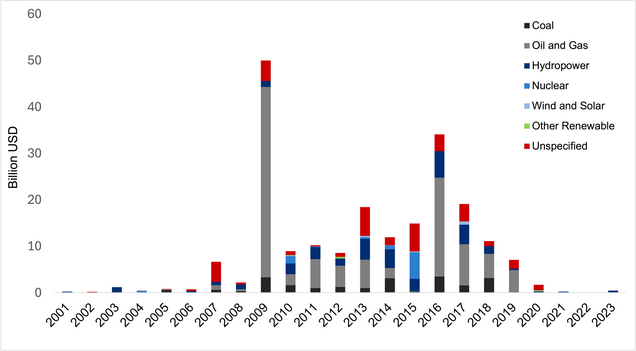
A new update to China’s Global Energy Finance (CGEF) Database, managed by the Boston University Global Development Policy Center, estimates that from 2000-2023, China’s two development finance institutions (DFIs)—the China Development Bank (CDB) and the Export-Import Bank of China (CHEXIM)—provided 367 loans, totalling $209 billion to 118 public borrowers in 68 countries for energy projects around the world.
For the year 2023, the CGEF Database recorded three new energy-related loan commitments from CHEXIM, totalling $502 million, to three African government borrowers – Madagascar, Burkina Faso and Uganda – marking a cautious comeback after a one-year hiatus. Yet, the amount committed in 2023 is only 6 per cent of the average annual lending total amount ($9 billion) for 2000-2022.
The CGEF Database is an interactive data project that provides an estimate of lending commitments for global energy projects from CDB and CHEXIM. The commitments tracked are international sovereign loans, which means the recipient is a public entity, a public majority or a private entity with a sovereign guarantee. It is important to note that CGEF Database loan amounts are not equivalent to government debt, as the database tracks commitments and not disbursement, repayments or defaults.
A new policy brief by Jiaqi Lu, Diego Morro, Shengheng Li and Thang Ha analyses the state of China’s global energy finance from 2000-2023.
Main findings:
- From 2000-2023, CDB and CHEXIM provided 367 loans, totalling $209 billion, to 118 public borrowers in 68 countries.
- Comparatively, the World Bank committed $43 billion to energy projects in the same period.
- During this time, oil and gas held the largest share of energy finance (50 per cent), followed by hydropower (18 per cent) and coal (10 per cent). Renewable sources of energy like wind and solar and other renewables account for just 1 per cent.
Figure 2: Chinese Lending by Energy Source, 2000-2023

- Asian countries received the highest amounts of China’s overseas energy finance at 31 per cent ($65 billion), whereas Africa, Latin America, the Caribbean and Europe received 26 per cent ($55 billion), 24 per cent ($51 billion) and 18 per cent ($38 billion), respectively.
- The top five recipients of Chinese energy loans are Russia ($35 billion, 17 per cent), Brazil ($28 billion, 13 per cent), Angola ($24 billion, 12 per cent), Venezuela ($14 billion, 7 per cent) and Pakistan ($10 billion, 5 per cent). These five countries borrowed more than half of all lending from 2000-2023.
- In 2023, CHEXIM financed three new renewable energy projects for a combined total of $502 million in three African countries – Madagascar, Burkina Faso and Uganda. All three projects involved non-fossil fuel energy, including two hydropower-related projects (one power plant and one transmission project) and a solar power plant.
- China’s lending in 2023 shows a shift towards smaller-scale projects, a departure from the large-scale projects that characterised the early BRI years (2013-2018). The average loan amount in 2023 was $167 million, which is significantly below the $574 million average loan amount for all energy loans committed from 2000-2022.
- Following recent commitments to support renewable energy and sustainable development made at the Ninth Forum on China-Africa Cooperation (FOCAC), Chinese overseas energy finance is set to rebound in the coming years with a decidedly green slant.
The next phase of China’s overseas energy finance will likely reveal the true extent of its commitment to renewable energy and sustainable development. While China’s move away from coal (and potentially all fossil fuels) demonstrates a remarkable change, the scope and scale of its future investments will ultimately determine its contribution to the global energy transition.


